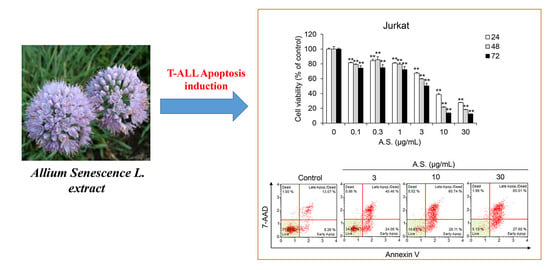Anti-Proliferative Effect of Allium senescens L. Extract in Human T-Cell Acute Lymphocytic Leukemia Cells
Abstract
1. Introduction
2. Results
2.1. A.S. Extract Induces Caspase-Dependent Apoptosis of T-ALL Cells
2.2. A.S. Extract Induces MAPK p38-Mediated ROS Production
2.3. A.S. Extract Inhibits the PMA/PHA-Mediated NF-κB Signaling Pathway and IL-2 mRNA Expression and Secretion
2.4. Combined Treatment with Tyrosine Kinase Inhibitors Exerts Enhanced Inhibitory Effects on T-ALL Cell Viability and IL-2 Expression
3. Discussion
4. Materials and Methods
4.1. Materials
4.2. Preparation of Plant Materials
4.3. PBMC Isolation and Cell Culture
4.4. Cell Viability Assay
4.5. Flow Cytometry
4.6. Western Blot Analyses
4.7. Quantitative Real-Time PCR (qRT-PCR)
4.8. Enzyme-Linked Immunosorbent Assay (ELISA)
4.9. Analysis of Combined Drug Effects
4.10. Statistical Analyses
5. Conclusions
Supplementary Materials
Author Contributions
Funding
Institutional Review Board Statement
Informed Consent Statement
Data Availability Statement
Acknowledgments
Conflicts of Interest
Sample Availability
References
- Parvu, M.; Toiu, A.; Vlase, L.; Alina Parvu, E. Determination of some polyphenolic compounds from Allium species by HPLC-UV-MS. Nat. Prod. Res. 2010, 24, 1318–1324. [Google Scholar] [CrossRef] [PubMed]
- Vlase, L.; Parvu, M.; Parvu, E.A.; Toiu, A. Chemical constituents of three Allium species from Romania. Molecules 2012, 18, 114–127. [Google Scholar] [CrossRef] [PubMed]
- Moreno-Black, G. Folk Medicine: The Art and the Science; Steiner, R.P., Ed.; The American Chemical Society: Washington, DC, USA, 1986; Volume 7, pp. 125–137. [Google Scholar]
- Batiha, G.E.-S.; Beshbishy, A.M.; Wasef, L.G.; Elewa, Y.H.A.; Abdel-Daim, M.M.; El-Hack, M.E.A.; Taha, A.E.; Abd-Elhakim, Y.M.; Devkota, H.P. Chemical Constituents and Pharmacological Activities of Garlic (Allium sativum L.): A Review. Nutrients 2020, 12, 872. [Google Scholar] [CrossRef] [PubMed]
- Kim, T.J. Korean Plants V; Seoul National University Press: Seoul, Korea, 1998. [Google Scholar]
- Shin, G.-M.; Koppula, S.; Chae, Y.-J.; Kim, H.-S.; Lee, J.-D.; Kim, M.-K.; Song, M. Anti-hepatofibrosis effect of Allium senescens in activated hepatic stellate cells and thioacetamide-induced fibrosis rat model. Pharm. Biol. 2018, 56, 632–642. [Google Scholar] [CrossRef] [PubMed]
- Noor, S.M.; Bell, R.; Ward, A.C. Shooting the messenger: Targeting signal transduction pathways in leukemia and related disorders. Crit. Rev. Oncol. Hematol. 2011, 78, 33–44. [Google Scholar] [CrossRef] [PubMed]
- Pui, C.H.; Evans, W.E. Acute lymphoblastic leukemia. N. Engl. J. Med. 1998, 339, 605–615. [Google Scholar] [CrossRef]
- Steward-Tharp, S.M.; Song, Y.J.; Siegel, R.M.; O’Shea, J.J. New insights into T cell biology and T cell-directed therapy for autoimmunity, inflammation, and immunosuppression. Ann. N. Y. Acad. Sci. 2010, 1183, 123–148. [Google Scholar] [CrossRef]
- Smith-Garvin, J.E.; Koretzky, G.A.; Jordan, M.S. T cell activation. Annu. Rev. Immunol. 2009, 27, 591–619. [Google Scholar] [CrossRef]
- Malek, T.R.; Castro, I. Interleukin-2 receptor signaling: At the interface between tolerance and immunity. Immunity 2010, 33, 153–165. [Google Scholar] [CrossRef]
- Dong, C.; Davis, R.J.; Flavell, R.A. MAP kinases in the immune response. Annu. Rev. Immunol. 2002, 20, 55–72. [Google Scholar] [CrossRef]
- Crabtree, G.R.; Clipstone, N.A. Signal transmission between the plasma membrane and nucleus of T lymphocytes. Annu. Rev. Biochem. 1994, 63, 1045–1083. [Google Scholar] [CrossRef]
- Mercurio, F.; Manning, A.M. Multiple signals converging on NF-kappaB. Curr. Opin. Cell Biol. 1999, 11, 226–232. [Google Scholar] [CrossRef]
- Mori, N.; Fujii, M.; Ikeda, S.; Yamada, Y.; Tomonaga, M.; Ballard, D.W.; Yamamoto, N. Constitutive activation of NF-kappaB in primary adult T-cell leukemia cells. Blood 1999, 93, 2360–2368. [Google Scholar]
- Sahraoui, Y.; Allouche, M.; Ammar, A.; Spanakis, E.; Clemenceau, C.; Jasmin, C.; Perraki, M.; Varela-Millot, C.; Georgoulias, V. Interleukin 2 production and interleukin 2 receptor expression by human immature leukemic T cells. Leukemia 1992, 6, 1025–1035. [Google Scholar]
- Jung, J.-I.; Kim, S.Y.; Park, K.-Y.; Sydara, K.; Lee, S.W.; Kim, S.A.; Kim, J. In vitro combinatorial anti-proliferative and immunosuppressive effects of Brucea javanica extract with CX-4945 and imatinib in human T-cell acute lymphoblastic leukemia cells. Biomed. Pharmacother. 2018, 106, 403–410. [Google Scholar] [CrossRef]
- Roesslein, M.; Frick, M.; Auwärter, V.; Humar, M.; Goebel, U.; Schwer, C.; Geiger, K.K.; Pahl, H.L.; Pannen, B.H.J.; Loop, T. Sevoflurane-Mediated Activation of p38-Mitogen-Activated Stresskinase is Independent of Apoptosis in Jurkat T-Cells. Anesthesia Analg. 2008, 106, 1150–1160. [Google Scholar] [CrossRef]
- Sui, X.; Kong, N.; Ye, L.; Han, W.; Zhou, J.; Zhang, Q.; He, C.; Pan, H. p38 and JNK MAPK pathways control the balance of apoptosis and autophagy in response to chemotherapeutic agents. Cancer Lett. 2014, 344, 174–179. [Google Scholar] [CrossRef]
- Suzuki, S.; Okada, M.; Shibuya, K.; Seino, M.; Sato, A.; Takeda, H.; Seino, S.; Yoshioka, T.; Kitanaka, C. JNK suppression of chemotherapeutic agents-induced ROS confers chemoresistance on pancreatic cancer stem cells. Oncotarget 2015, 6, 458–470. [Google Scholar] [CrossRef]
- Lin, A.; Dibling, B. The true face of JNK activation in apoptosis. Aging Cell. 2002, 1, 112–116. [Google Scholar] [CrossRef] [PubMed]
- Stajner, D.; Milić, N.; Canadanović-Brunet, J.; Kapor, A.; Stajner, M.; Popović, B.M. Exploring Allium species as a source of potential medicinal agents. Phytother. Res. 2006, 20, 581–584. [Google Scholar] [CrossRef]
- Khazaei, S.; Ramachandran, V.; Hamid, R.A.; Esa, N.M.; Etemad, A.; Moradipoor, S.; Patimah, I. Flower extract of Allium atroviolaceum triggered apoptosis, activated caspase-3 and down-regulated antiapoptotic Bcl-2 gene in HeLa cancer cell line. Biomed. Pharmacother. 2017, 89, 1216–1226. [Google Scholar] [CrossRef]
- Moutia, M.; Habti, N.; Badou, A. In Vitro and In Vivo Immunomodulator Activities of Allium sativum L. Evid. Based Complement Alternat. Med. 2018, 2018, 4984659. [Google Scholar] [CrossRef]
- Isbilen, O.; Rizaner, N.; Volkan, E. Anti-proliferative and cytotoxic activities of Allium autumnale P. H. Davis (Amaryllidaceae) on human breast cancer cell lines MCF-7 and MDA-MB-231. BMC Complement Altern. Med. 2018, 18, 30. [Google Scholar] [CrossRef]
- Bravo, L. Polyphenols: Chemistry, dietary sources, metabolism, and nutritional significance. Nutr. Rev. 1998, 56, 317–333. [Google Scholar] [CrossRef]
- Kendler, B.S. Garlic (Allium sativum) and onion (Allium cepa): A review of their relationship to cardiovascular disease. Prev. Med. 1987, 16, 670–685. [Google Scholar] [CrossRef]
- Čolić, M.; Savić, M. Garlic Extracts Stimulate Proliferation of Rat Lymphocytes in Vitro by Increasing IL-2 and IL-4 Production. Immunopharmacol. Immunotoxicol. 2000, 22, 163–181. [Google Scholar] [CrossRef]
- Inoue, T.; Mimaki, Y.; Sashida, Y.; Nishino, A.; Satomi, Y.; Nishino, H. Steroidal glycosides from Allium macleanii and A. senescens, and their inhibitory activity on tumour promoter-induced phospholipid metabolism of HeLa cells. Phytochemistry 1995, 40, 521–525. [Google Scholar] [CrossRef]
- Sena, L.A.; Chandel, N.S. Physiological roles of mitochondrial reactive oxygen species. Mol. Cell 2012, 48, 158–167. [Google Scholar] [CrossRef]
- Zhang, J.; Wang, X.; Vikash, V.; Ye, Q.; Wu, D.; Liu, Y.; Dong, W. ROS and ROS-Mediated Cellular Signaling. Oxid. Med. Cell Longev. 2016, 2016, 4350965. [Google Scholar] [CrossRef]
- Yang, T.; Yao, S.; Zhang, X.; Guo, Y. Andrographolide inhibits growth of human T-cell acute lymphoblastic leukemia Jurkat cells by downregulation of PI3K/AKT and upregulation of p38 MAPK pathways. Drug Des. Devel. Ther. 2016, 10, 1389–1397. [Google Scholar] [CrossRef]
- Okabe, S.; Tauchi, T.; Tanaka, Y.; Sakuta, J.; Ohyashiki, K. Anti-leukemic activity of axitinib against cells harboring the BCR-ABL T315I point mutation. J. Hematol. Oncol. 2015, 8, 97. [Google Scholar] [CrossRef][Green Version]
- Stehle, F.; Schulz, K.; Fahldieck, C.; Kalich, J.; Lichtenfels, R.; Riemann, D.; Seliger, B. Reduced immunosuppressive properties of axitinib in comparison with other tyrosine kinase inhibitors. J. Biol. Chem. 2013, 288, 16334–16347. [Google Scholar] [CrossRef]
- Eucker, J.; Zang, C.; Zhou, Y.; Li, X.; Habbel, P.; Schulz, C.O.; Scholz, C.; Liu, H. TKI258, a multi-tyrosine kinase inhibitor is efficacious against human infant/childhood lymphoblastic leukemia in vitro. Anticancer Res. 2014, 34, 4899–4907. [Google Scholar]
- Lopes de Menezes, D.E.; Peng, J.; Garrett, E.N.; Louie, S.G.; Lee, S.H.; Wiesmann, M.; Tang, Y.; Shephard, L.; Goldbeck, C.; Oei, Y.; et al. CHIR-258: A potent inhibitor of FLT3 kinase in experimental tumor xenograft models of human acute myelogenous leukemia. Clin. Cancer Res. 2005, 11, 5281–5291. [Google Scholar] [CrossRef]
- Eucker, J.; Zang, C.; Zhou, Y.; Li, X.; Habbel, P.; Neumann, C.; Scholz, C.; Liu, H. The multi-tyrosine kinase inhibitor TKI258, alone or in combination with RAD001, is effective for treatment of human leukemia with BCR-ABL translocation in vitro. Anticancer Res. 2014, 34, 4909–4914. [Google Scholar] [PubMed]
- Nguyen, A.T.; Duez, P. Cytotoxic-anticancer drugs from medicinal plants. In Phytochemistry Research Progress; Matsumoto, T., Ed.; Nova Science Publishers, Inc.: New York, NY, USA, 2008; pp. 193–208. [Google Scholar]
- Livak, K.J.; Schmittgen, T.D. Analysis of relative gene expression data using real-time quantitative PCR and the 2(-Delta Delta C(T)) Method. Methods 2001, 25, 402–408. [Google Scholar] [CrossRef]
- Chou, T.C.; Talalay, P. Quantitative analysis of dose-effect relationships: The combined effects of multiple drugs or enzyme inhibitors. Adv. Enzyme Regul. 1984, 22, 27–55. [Google Scholar] [CrossRef]
- Zhao, L.; Wientjes, M.G.; Au, J.L. Evaluation of combination chemotherapy: Integration of nonlinear regression, curve shift, isobologram, and combination index analyses. Clin. Cancer Res. 2004, 10, 7994–8004. [Google Scholar] [CrossRef]
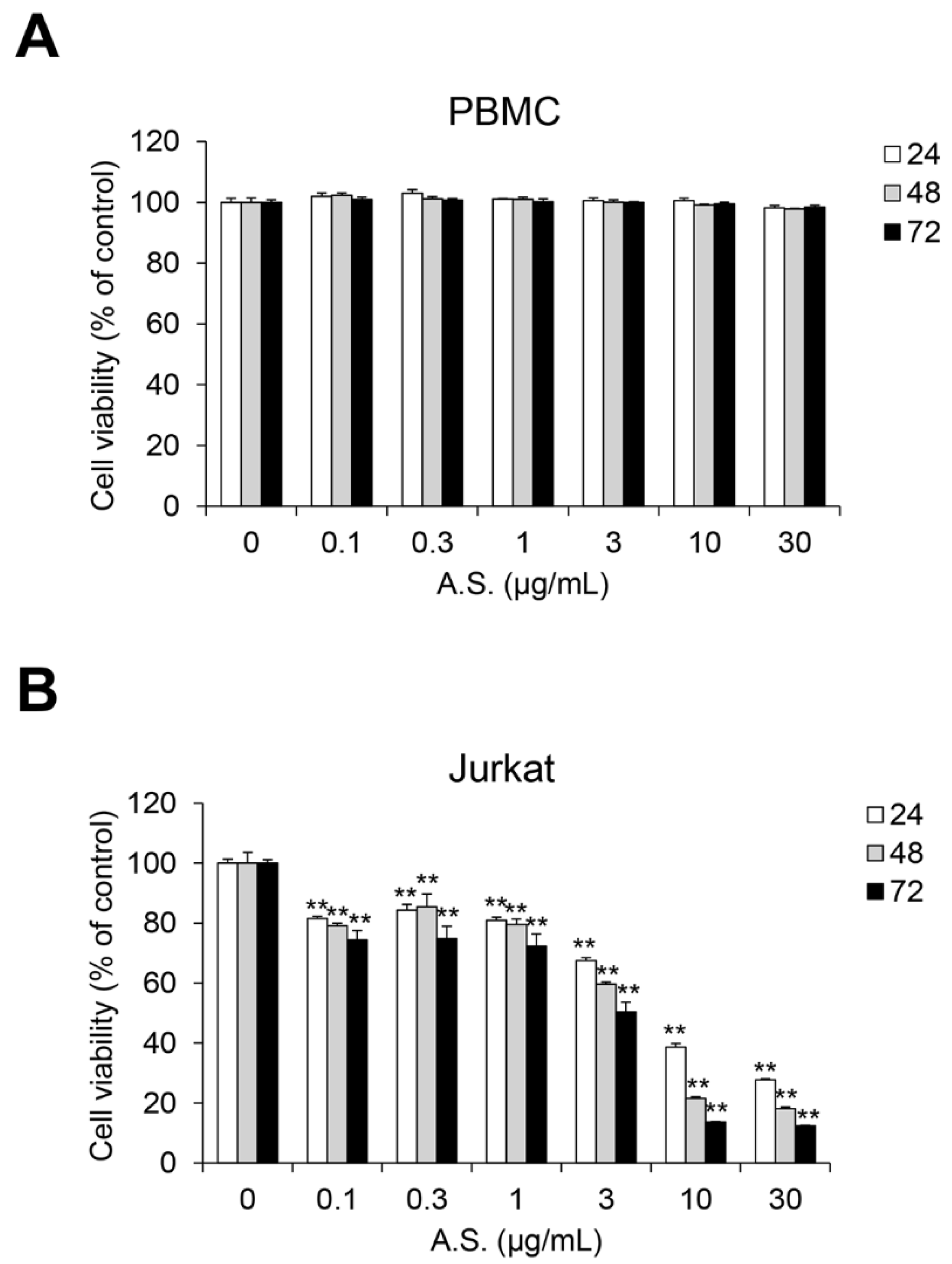
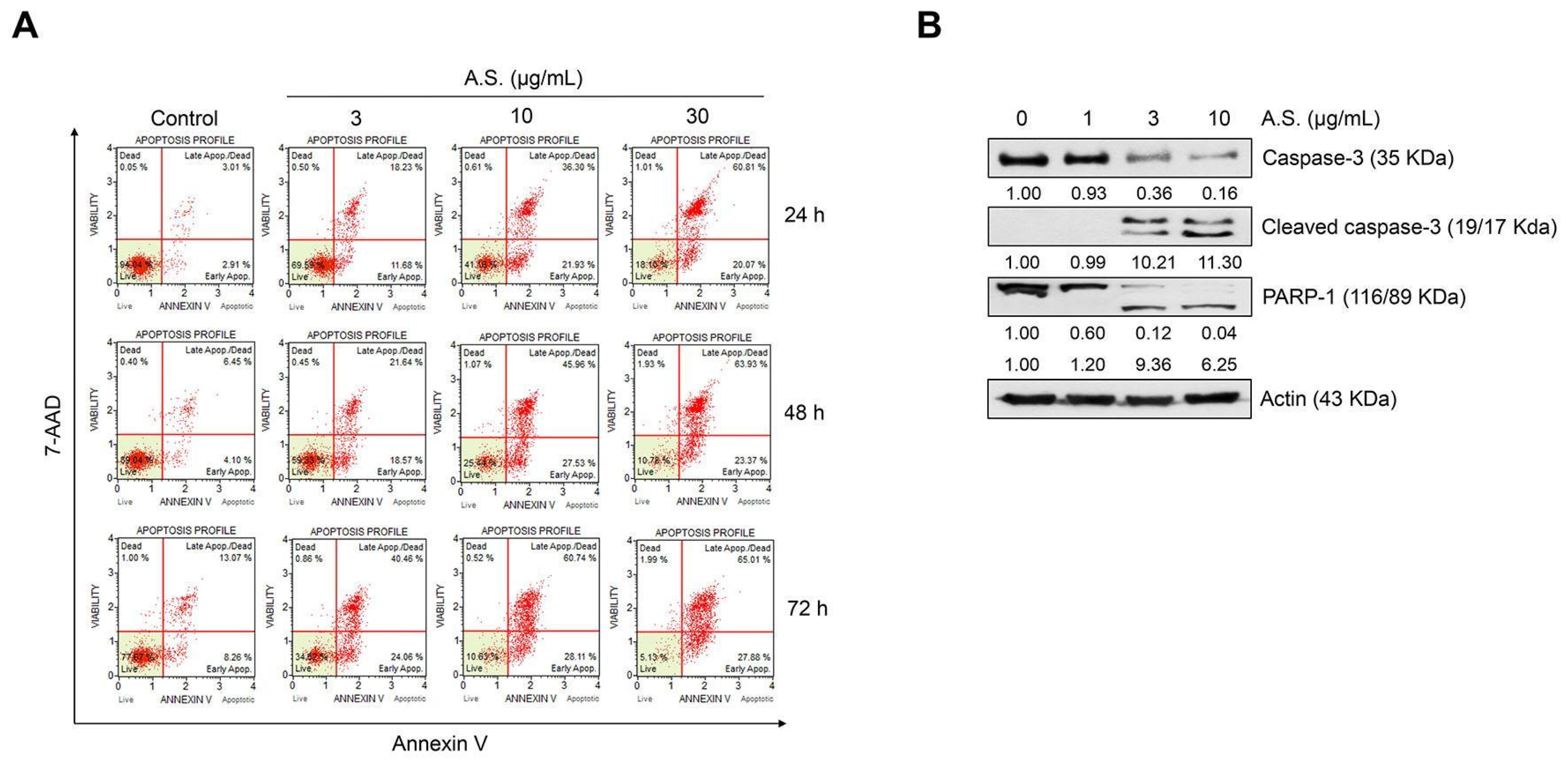
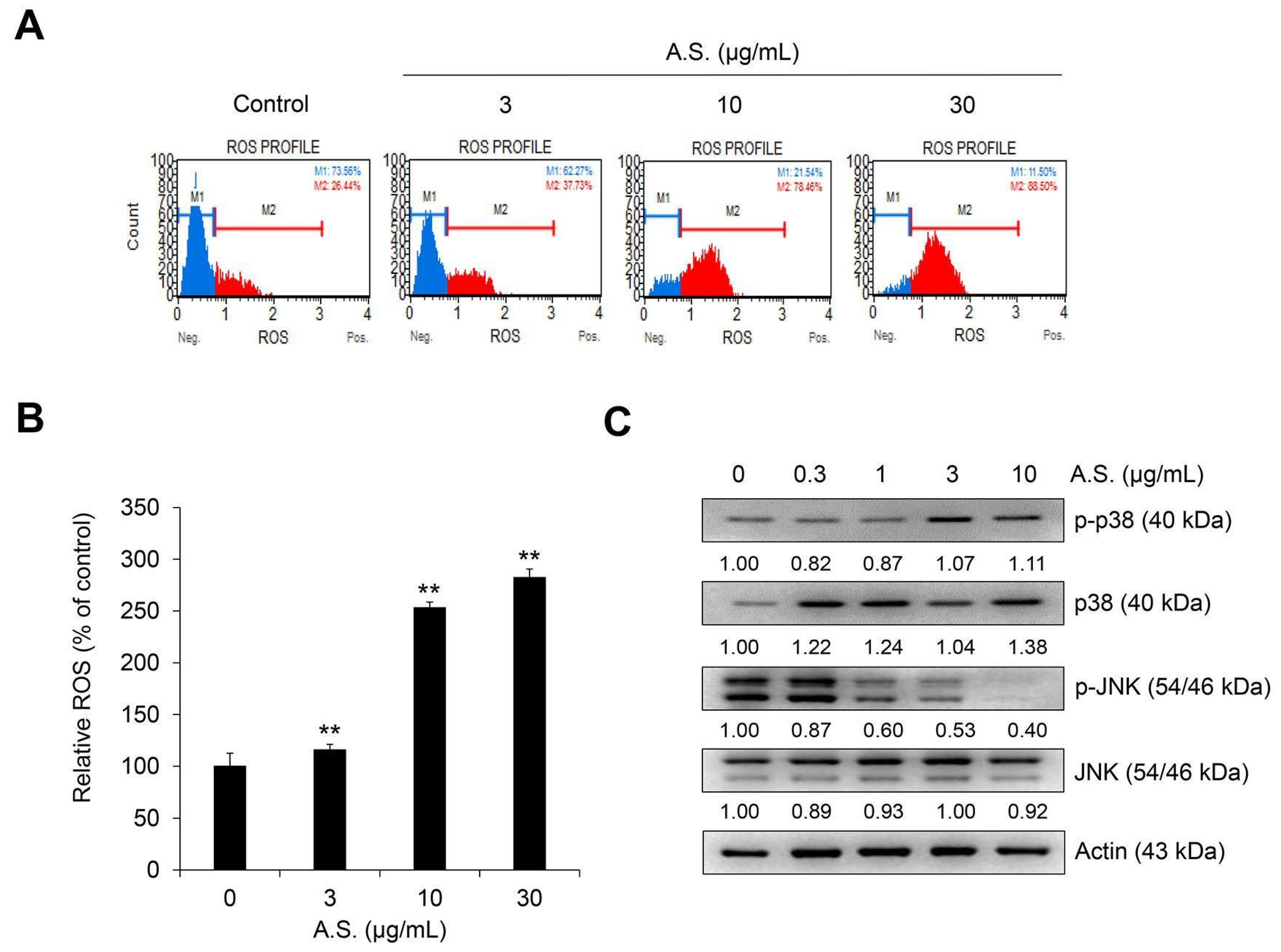
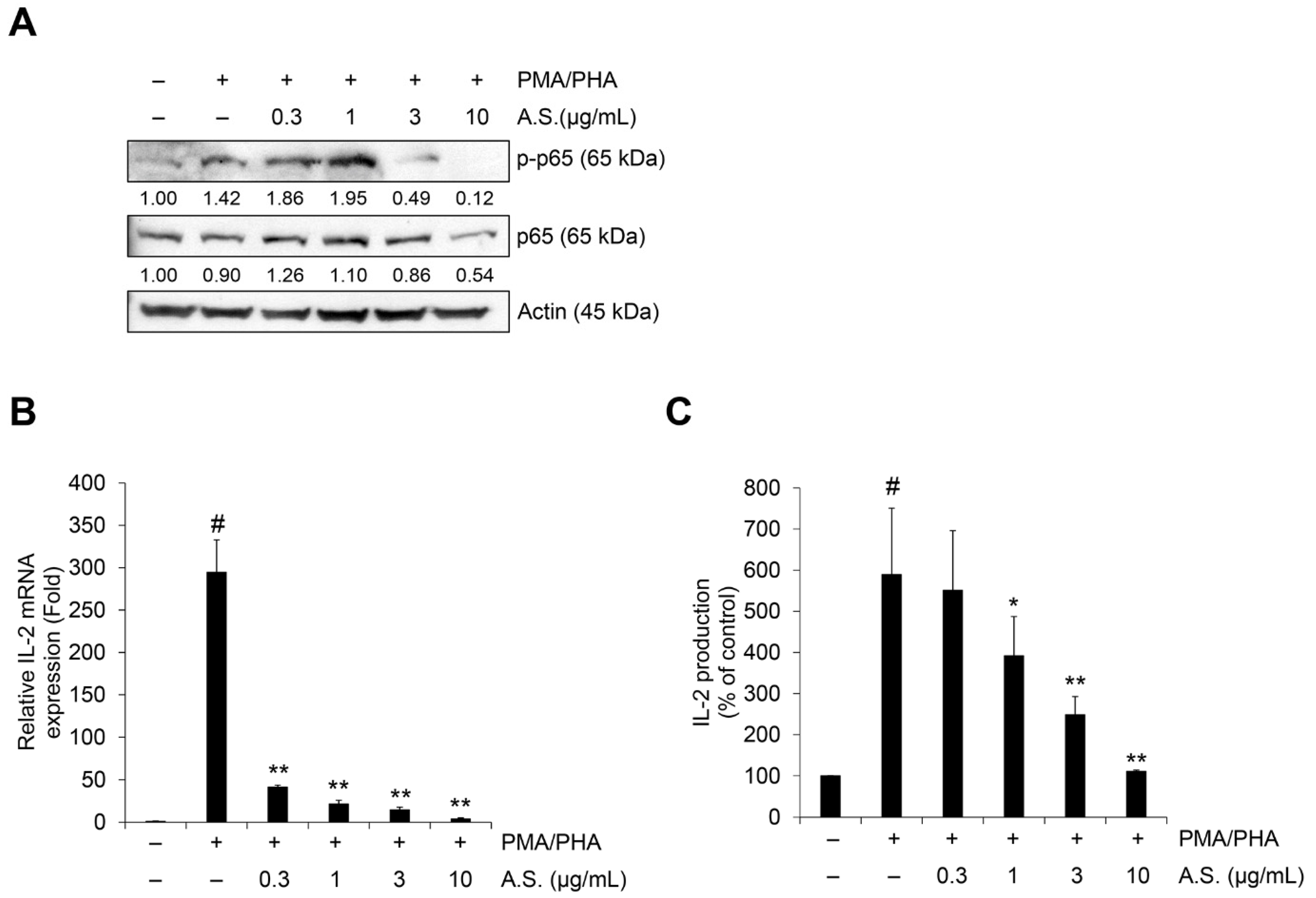
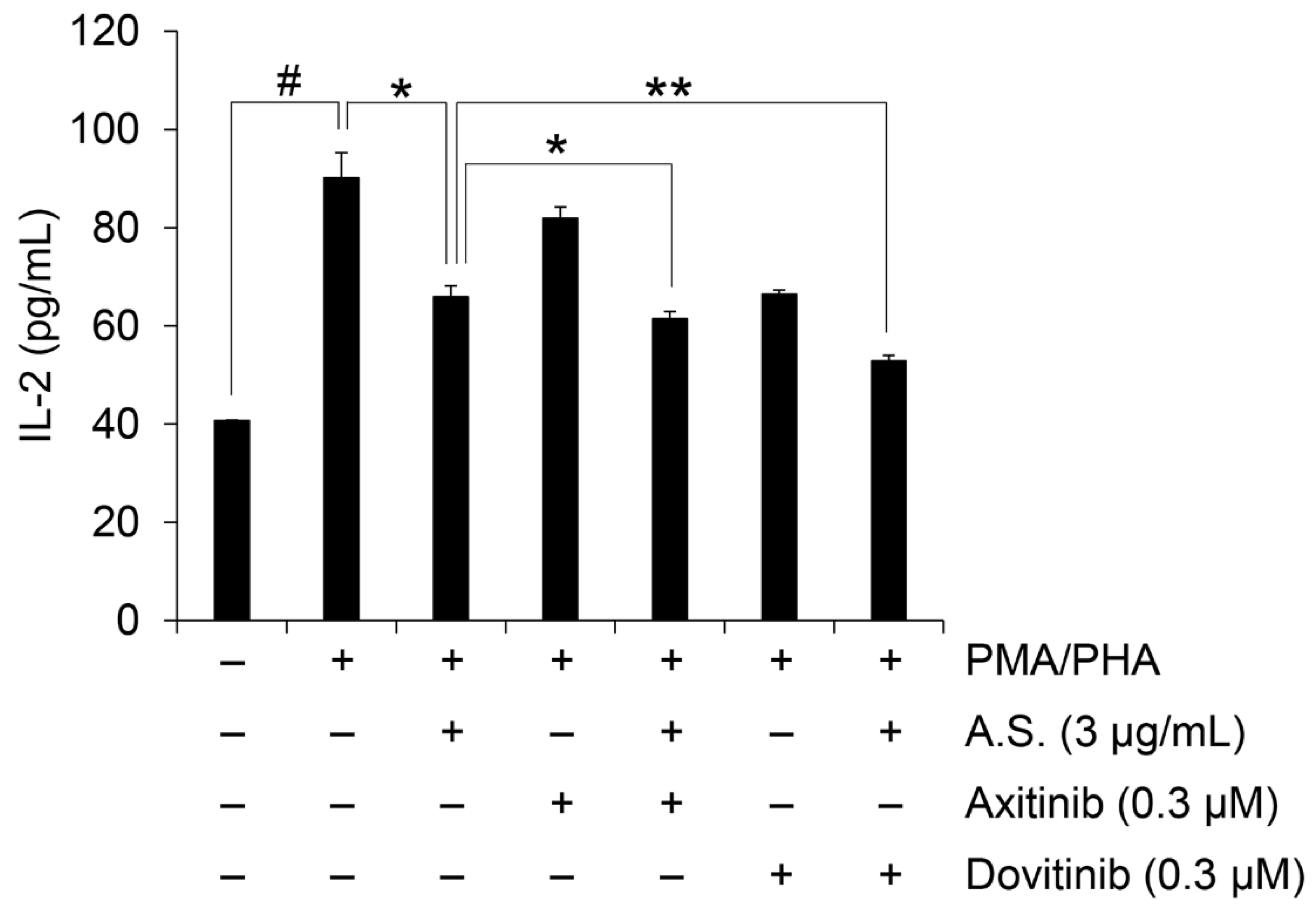
| A.S. (μg/mL) | Axitinib (μM) | Cell Viability (% of Control) | CI Value |
|---|---|---|---|
| 0.1 | 0.1 | 53.2848 | 0.0509 |
| 0.3 | 0.3 | 54.1178 | 0.1635 |
| 1 | 1 | 49.6011 | 0.3768 |
| 3 | 3 | 40.3136 | 0.5126 |
| 10 | 10 | 21.8325 | 0.2472 |
| 30 | 30 | 19.3219 | 0.5259 |
| A.S. (μg/mL) | Dovitinib (μM) | Cell viability (% of Control) | CI Value |
| 0.1 | 0.1 | 54.7622 | 0.1108 |
| 0.3 | 0.3 | 52.7178 | 0.3747 |
| 1 | 1 | 38.6599 | 0.5515 |
| 3 | 3 | 22.6882 | 0.5816 |
| 10 | 10 | 19.1636 | 0.4195 |
| 30 | 30 | 19.6665 | 0.8337 |
Publisher’s Note: MDPI stays neutral with regard to jurisdictional claims in published maps and institutional affiliations. |
© 2020 by the authors. Licensee MDPI, Basel, Switzerland. This article is an open access article distributed under the terms and conditions of the Creative Commons Attribution (CC BY) license (http://creativecommons.org/licenses/by/4.0/).
Share and Cite
Kim, J.; Lee, D.H.; Badamtsetseg, B.; Lee, S.; Kim, S.A. Anti-Proliferative Effect of Allium senescens L. Extract in Human T-Cell Acute Lymphocytic Leukemia Cells. Molecules 2021, 26, 35. https://doi.org/10.3390/molecules26010035
Kim J, Lee DH, Badamtsetseg B, Lee S, Kim SA. Anti-Proliferative Effect of Allium senescens L. Extract in Human T-Cell Acute Lymphocytic Leukemia Cells. Molecules. 2021; 26(1):35. https://doi.org/10.3390/molecules26010035
Chicago/Turabian StyleKim, Jiyeon, Dae Han Lee, Bazarragchaa Badamtsetseg, Sangwoo Lee, and Soon Ae Kim. 2021. "Anti-Proliferative Effect of Allium senescens L. Extract in Human T-Cell Acute Lymphocytic Leukemia Cells" Molecules 26, no. 1: 35. https://doi.org/10.3390/molecules26010035
APA StyleKim, J., Lee, D. H., Badamtsetseg, B., Lee, S., & Kim, S. A. (2021). Anti-Proliferative Effect of Allium senescens L. Extract in Human T-Cell Acute Lymphocytic Leukemia Cells. Molecules, 26(1), 35. https://doi.org/10.3390/molecules26010035





